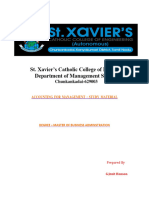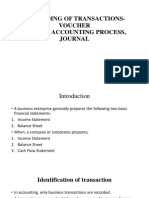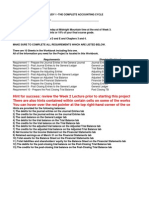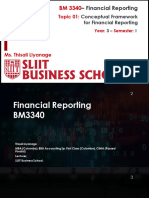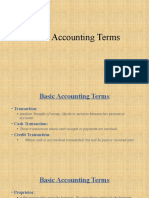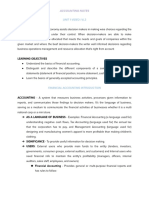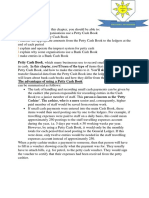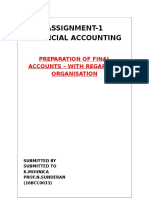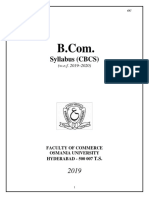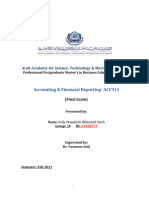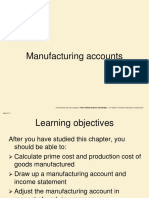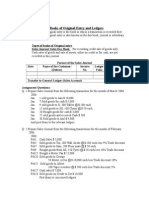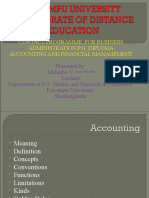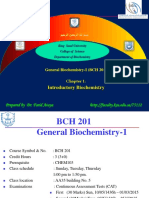BASIC OF ACCOUNTING
INTRODUCTION
Accounting is a language of business. It is mainly used to
communicate the result and information required by the interested
parties like management, creditors, bank govt., etc. in the being the
main objective of accounting was to acertain profit &loss during a
year and to show the financial position of a business concern at a
particular date.
DEFINITION
The American Institute of Certified Public Accountants
(AICPA) define accounting as” The art of recording classifying
and summarizing, in a significant manner and in terms of money,
transaction and events which are, in part at least of financial
character, and interpreting the result thereof.
The American Accounting Association (AAA) define
accounting as follows “accounting is the process identifying
measuring and communicating economic information to permit
informed judgment and decision by users of information.
FUNCTIONS OF ACCOUNTING
1.It keeps a systematic record of business transaction of the
business.
2.It keeps a record of income and expenses.
3.It enables to know the net result of the business concern at a
particular period.
4.It keeps a record of all assets and liability
5.It analyses and interprets the recorded data.
6.It communicates the results of the business to various interested
parties like investors, creditors etc.
BRANCHES OF ACCOUNTING
�1. FINANCIAL ACCOUNTING
It is a original form of accounting .It is mainly related with
preparation of financial statement for the use of outsiders like share
holders, debenture holders creditors, bank and other financial
institution .The financial comprises Trading and profit &loss
Account and Balance Sheet.
2.COST ACCOUNTING
3.MANAGEMENT ACCOUNTING
ACCOUNTING SYSTEM
1.CASH SYSTEM
Under this system actual cash receipt and payments are
recorded. Credit transactions are not recorded. It is only
recorded after receipt and payment is done.
2.MERCANTIL SYSTEM
Under this system all transaction related to a particular
period are recorded in the books of account. This system gives
a complete picture of financial transactions of particular
period.
3.MIXED SYSTEM
Cash system and mercantile system are following
concern, certain transaction are recorded to cash system and
other in mercantile system.
BASIC TERMS USED IN ACCOUNTING
1 ASSET
The valuable things or properties owned by the business
are called assets. Which can be expressed in monetary
terms .Assets are broadly classified in to fixed assets and
current assets.
A) FIXED ASSETS
Assets which are required for long- term use in
the business are called fixed assets.
Eg: - land and building, machinery, furniture etc.
� B) CURRENT ASSETS
Assets which are held forshort period are called
current assets.
Eg: - stock, debtors, cash in hand, cash at bank.
Fixed assets are broadly classified in to two
a)Tangible assets :- it can be touched ,seen and felt
Eg; - machinery, furniture
b)Intangible assets:- it cannot be touched , seen and felt
Eg: - goodwill, trade mark copy right.
2. LIABILITY
Liabilities are obligation or debts payable by the
enterprise in future in the form of money or goods.
3. CAPITALS
Capital in the investment made by the owner for
use in the business. Capital will be the equal to total assets
of the firm minus liabilities of the firm.
4. Drawing
It represents the amount of cash or other assets
Withdrawn by the owner for the personal purpose.
5. Income (revenue)
These are the amounts earned by a business concern
by selling its products or rendering service to its customers.
eg:- commission received, rent received etc.
6. Expenses
Expenses are the amount spent in the process of
earning income.
7 sales
It represents total revenue earned by a business
through sale of goods or service to customer.
� 8. Purchases
The total amount of goods purchased by a business
Concern for cash or credit for the purpose of sales or
Use in business is known as purchase.
9. Stock
The goods available with the business for sale on
a particular date termed as stock. The value of goods remaining
unsold at the end of an accounting period is termed as closing
stock and at the beginning of an accounting period is termed as
opening stock.
10. Debtors
Debtors are persons who owe money to the business
for goods sold on credit. Debtors are also referred to as accounts
receivables.
11. Creditors
Creditors are person who have claim for money
against the business for goods supplied on credit. Creditors are
also referred to as accounts payables.
Business transaction
A business transaction is a dealing, which has an impact
on the business.
1. Cash Transaction
A cash transaction refers to any business transaction,
which involves immediate payment or receipt of cash.
Eg: - purchase of goods for cash.
2. Credit Transaction
It is transaction where payment or receipt to post pone
for future date.
Eg: - goods sold on credit.
Systems of Accounting
There are many ways of classifying the systems of
accounting. The most popular ways are.
�1.Single Entry Systems
It is systems of accounting under which only one aspect
(debit or credit) of the transaction are recorded. It is usually used
by a small concerns which have a very few transaction.
2.Double entry systems
In the double entry systems of book- keeping a complete
record of both the aspects – (‘a receiving aspects and giving
aspects’) of every transaction is maintained.
Account
An account is a summery of business transaction affecting a
person or property or an income or an expense. An account is the
statement which is recorded transactions of similar nature
relating to a particular item at one place.
KINDS OF ACCOUNTS
Traditional or English approach
Conventional approach accountants are classified into
three. They are
1 personal account.
Personal accountants are accountants of persons, firms
or companies with whom the business deals.
Eg:-Anil a/c, ABC & Co ltd account etc.
2 Real Accounts
Real accounts are accounts of assets or properties.
Example cash account, furniture account, building account etc.
3.Nominal account
These are the accounts related to all types’ expenses,
incomes, losses and gain. Eg: - salary account, rent account,
commission account etc.
� Rules of Accounting
Name Debit Credit
Personal a/c The receiver The giver
Real a/c What comes in What goes out
Nominal a/c All expenses & losses All income & gain
Accounting equation
Modern approach or American approach
American accountant have divided the rates of
debit and credit through accounting equation. This is given
below.
Assets = Equities
Assets are the properties owned by a business. Right to
properties is known as equity of the business. Equity can be
classified into
a) Creditors equity : which represent debts of the business
(Liability)
b) Owners equity : which represent capital
So Assets = owners equity + creditors equity
Or
Assets = liability + capital
Rules based on accounting equation
According to accounting equation the
rules relating to assets, liability, capital, expenses and
income are as follows,
� S.n.o Name Debit Credit
1 Assets Increase Decrease
2 Liability Decrease Increase
3 Capital Decrease Increase
4 Expenses increase Decrease
5 Income Decrease Increase
JOURNAL
Journal is the books of original entry in which transactions
are first recorded in the order in which they occur. The process of
recording transactions in a journal is termed as journalizing and
the transactions entered in the journal are called journal entries.
Format of journal
Amount
Date particular Lf
Debit credit
LEDGER
` A ledger is the most important books in an
organization. A ledger is defined as a collection of all the
accounts debited or credited in the general journal. It contains a
summarized record of all the transactions of the period.
Format of ledger
Dr Cr
Date Particular J/f Amount Date Particular J/f Amount




